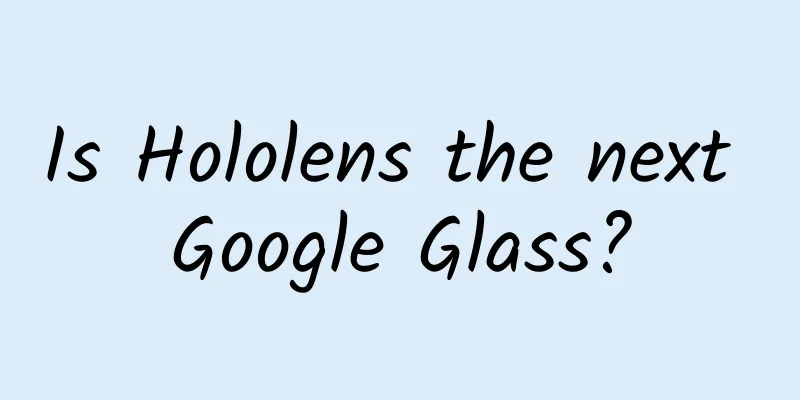Is Hololens the next Google Glass?

|
At the Windows 10 launch event yesterday, Microsoft released an augmented reality device, HoloLens, which is the most high-tech product Microsoft has launched in the past decade, bar none! It looks more like an evolved version of Google Glass. Hololens is the first consumer-oriented augmented reality device. Unlike other augmented reality devices, Microsoft brings holographic life experience services to users through HoloLens and forms a complete set of solutions. It can understand the user's gestures, voice and surrounding space environment. HoloLens allows you to enter a future world and give you an amazing user experience. It is different from the virtual reality glasses released by Samsung before, which must be equipped with Galaxy Note4 to use. It is a completely independent computing device with built-in CPU, GPU and a dedicated holographic processor. This head-mounted device includes a transparent display on the black lens, and the stereo sound system allows users to not only see but also hear the sound from the surrounding holographic scene. At the same time, HoloLens also has a set of built-in sensors to realize various functions. Currently, it can track people's gestures and eye movements, so the screen and projection will move with people's movements. For the Hololens project, the most successful part may be how the augmented reality holographic projection deceives the brain: it makes the brain treat the light it sees as a real object. In the understanding of this black technology team, their ultimate goal is to make people perceive the world of light, which both exists and does not exist. What's important is to make the brain think it is in a physical world. The human-computer interaction form adopted by HoloLens: SLAM modeling and overlay: When using HoloLens smart glasses, you need to use SLAM to pre-model the scene before you can overlay 3D models, videos, windows, and other content on the real scene model. Microsoft previously released a technical patent similar to Google's Project Tango, and SLAM is relatively simple. However, this method is not suitable for use in open outdoor spaces and unknown spaces, and can only be used in limited spaces (usually indoors) and close-range basically fixed scenes or targets. Depth of field adaptation: Due to the use of SLAM method, the parallax principle can be used to achieve depth of field adaptation when AR is superimposed on the modeled scene and modeled content, so that the human eye can see the target and AR information at the same time during binocular perspective. However, depth of field adaptation cannot be achieved for unknown targets that have not been modeled; Gesture recognition: Based on structured light sensors, similar to LeapMotion and Kinect. Technical difficulties of HoloLens: 1. Perspective effect: that is, the problem of visual transmittance under conditions such as strong outdoor light and light interference. They have not yet solved this problem. If this problem is not solved, it is obvious that HoloLens cannot be used on the street. 2. Target recognition under actual conditions: Target recognition is an essential basic function for smart glasses for this purpose. It can recognize targets under actual conditions such as large-scale changes, tilt, occlusion, reflection, simple features and complex backgrounds. 3. Targeted AR under universal conditions: There may not be conditions and time to model every unknown scene and target, and AR at this time has not yet been solved; 4. Depth of field adaptation under universal conditions: HoloLens cannot achieve depth of field adaptation for targets and scenes that have not been pre-modeled. Either limit the application targets and scenes, or model them at any time, or measure with a laser rangefinder at any time, or use a binocular camera to measure distance. 5. Others: The manufacturing cost of holographic waveguide is high, and the optical quality of imaging is still poor. The visual computing using so many cameras and sensors has extremely high requirements on the processing power of CPU and GPU. Asic and some professional-grade chips are needed. Cost and battery life are a problem. Differences between Hololens and Google Glass If we talk about HoloLens, we must compare it with Google Glass, which was released by Google in 2012. In 2012, Brin led a group of models wearing Google Glass to walk a fashion show at the New York Fashion Week, trying to tell consumers that Google Glass is a product that leads the fashion trend. The AR technology displayed by Google Glass at that time was also shocking. Widely sought after by the media, Google Glass can be said to be the star product of 2012! It is like a Pandora's box. Once people open it, it will open a key to the future world. The ultimate goal of both HoloLens and Glass is to integrate technology into every corner of people's lives. From the appearance of the devices, Glass and HoloLens have taken two routes to achieve the goal of seamless integration of technology and daily life. Glass's choice is very ambitious. From the beginning, he did not want to hinder people's normal life. Yes, we want to integrate technology with daily life, but it must be seamless! So from the beginning, Glass chose to compress the body and choose a small screen, so the functions it can provide are not many. But this is Glass's belief, that is, no matter what, this device cannot take the place of the main feature. We can add functions little by little with the advancement of technology in the future, but we don't want to press a big thing on your face and make you wear it every day. Glass chose to add. So Glass emphasizes that we can wear this thing when running, cooking, and playing with children. HoloLens is obviously different. Microsoft's ambition is to make HoloLens a consumer product that accompanies people's lives every day like smartphones. HoloLens is not intended to replace smartphones, but to occupy people's time and energy to use mobile phones. Just like the iPad back then, it is not intended to replace PCs. So the question is, will wearing HoloLens like goggles while walking on the street make you look cool and stupid? The psychology of people wearing cutting-edge technology products is very strange. They want people to know that this is the coolest technology product, but they don’t want to attract attention and make others feel weird. When Google was developing Glass, it was designed to be a pair of glasses that people would wear daily, so you wouldn't feel awkward wearing Glass in your daily life, and you can use it whenever you want. The biggest drawback of Glass is that there are too few practical scenarios for people to use it, and there are not many AR apps that really affect people's lives. It just popularized AR devices, but in real life, it is just a useless product. When Microsoft was developing HoloLens, it was designed as an indoor product. When you put on HoloLens, you can see virtual scenes that are almost like a projector. For example, Youku has developed an app specifically for HoloLens. When you wear HoloLens, you can enter the Youku app through gestures. Every video you see in it is projected in front of you, but it is actually virtual and cannot be touched. You can only see it, as if you are living in a parallel space that is both real and virtual. This viewing effect is actually the same as that shown by Sony's head-mounted display. HoloLens is currently too large, which is a compromise that Microsoft has to make in order to maintain the performance of the machine. Only with sufficient performance can various cool applications be produced on HoloLens. However, technological products are often iterative, and through continuous technological development, the size of HoloLens can be reduced in the future until it is small enough for people to carry around. The ideas that Microsoft and Google came up with when developing augmented reality devices are undoubtedly more realistic, easier to create hot spots, and more easily accepted by people. After all, everyone now has Android or Apple, and Glass can only check emails and take photos, and it will overheat and restart at any time, which is obviously unacceptable to people. Looking back at history, we will find that electronic devices are getting smaller little by little, and TVs, computers, mobile phones, etc. have all changed from bulky big guys to small and smart ones that people can accept. After all, it is the practical and effective functions themselves that bring about technological changes, not the relationship between devices and life. Many technological products have beautiful ideals, but cruel realities. HoloLens also faces many challenges, even more than Google Glass. If it succeeds one day in the future, it will undoubtedly be the next cross-era technological product that affects millions of people after the iPhone. As a winner of Toutiao's Qingyun Plan and Baijiahao's Bai+ Plan, the 2019 Baidu Digital Author of the Year, the Baijiahao's Most Popular Author in the Technology Field, the 2019 Sogou Technology and Culture Author, and the 2021 Baijiahao Quarterly Influential Creator, he has won many awards, including the 2013 Sohu Best Industry Media Person, the 2015 China New Media Entrepreneurship Competition Beijing Third Place, the 2015 Guangmang Experience Award, the 2015 China New Media Entrepreneurship Competition Finals Third Place, and the 2018 Baidu Dynamic Annual Powerful Celebrity. |
<<: Why did Lenovo get a great bargain by buying MOTO?
Recommend
Urgent reminder! "Double typhoons" are approaching, and the intensity may exceed expectations! How to respond and prevent scientifically?
Central Meteorological Observatory issues typhoon...
Zhihu Product Analysis Report
In 2021, Zhihu celebrates its tenth anniversary, ...
PC business downgraded Intel servers first adopt 10nm process
Intel predicts that in five years, PC chips will b...
Zheng Duoyan [Fat Burning] Series
Zheng Duoyan's [Burning Fat] series resource ...
How do small businesses do marketing promotion?
Attracting users and increasing purchase return r...
Olympic champion Zheng Qinwen insists on eating chicken breast and broccoli for 360 days. Can ordinary people do the same?
Review expert: Peng Guoqiu, deputy chief physicia...
SEM promotion effect is not good, what aspects should be adjusted?
Why does the problem of poor SEM promotion effect...
In just 4 steps, you can quickly create heartfelt social advertising ideas!
Today I will analyze a social advertisement in Mo...
Android 7.0 ranks first in market share: Have you upgraded?
A few days ago, Google released the latest statis...
What are those plants that look like garlic? Recognize them, beware of poison!
Produced by: Science Popularization China Author:...
Aspartame is classified as a Class II carcinogen. Is it really dangerous?
Introduction: Staying away from aspartame is a wi...
What exactly does the “zero additives” on food packaging mean?
On March 27, 2023, the new version of food safety...
How to do Taobao customer promotion now?
Friends who are familiar with online store operat...
It is said that "the West emphasizes science, while the East emphasizes technology". Is science really useless?
The 26th roundtable dialogue on Gezhi Lundao in t...









